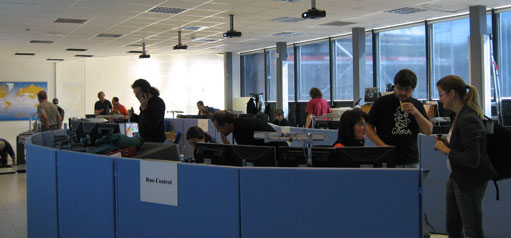
ATLAS e-News
23 February 2011
Control room raring to go
8 September 2008

The Control Room, morning of Friday September 5th
With the cavern now sealed off and the count-down to LHC start-up almost over, the epicentre of the most visible ATLAS activity – in human terms at least – has shifted 100 metres skywards, from the pit to the Control Room. Time, then, for the regular News from the Pit column to graciously step aside and make way for News from the Control Room – eNews’s brand spanking new column where we’ll be dutifully serving up regular updates of all the goings-on at Point 1 for your delectation.
For the shifters in the CR right now, things must feel a little like they did on Christmas Eve when they were five years old – waiting impatiently for the day to finally come, squeezing and rattling the presents under the tree, but still not knowing exactly what they’re going to get. For the last month, the combined detector has been running overnight and at weekends, giving them and the on-call experts a tantalising taste of what it’s going to be like on shift, and essential practice at on-the-spot problem solving. Now they’re itching to get started for real.
“Four months ago, when the beam schedule was delayed by a few weeks, people were slightly relieved,” says TileCal run coordinator Monica Dunford, “but now everyone wants the beam. Right now.”
Most shifters have been at the CR until 11 p.m. each night for the duration of the combined run. Exhausting work, yes, but it has given those involved the confidence to know that they are able to deal with problems as they arise. “There certainly have been hiccups along the way and there will be many, many more,” concedes Monica. But by oiling the wheels of the problem-solving mechanisms in advance, they have armed themselves with the sort of self-assurance that is “really important as we go into this stressful 'turn-on' situation.”
“It isn’t to say that there aren't things we still need to work on, but we want to give it a go. It’s like we’re sitting in the driver's seat of this nice fancy car and the beam people are dangling the keys just outside the window,” Monica explains. “We just want those keys so that we can take the car for a test drive!”
The reality of being ‘on shift’ will vary according to sub-detector or experimental region (safety, trigger, data quality). For TileCal, this will mean monitoring the hardware to make sure the power and cooling are within spec, as well as watching out for dead or hot channels that could affect data-taking. For the other areas, the specifics will vary, but the basic concept of keeping an eye on the hardware condition and performance remains the priority for all groups.
It’s not a glamorous job, but it’s a bread-and-butter role when it comes to the running of ATLAS, and one in which most people are keen to involve themselves. During run phases, this babysitting of the detector is the closest anyone can get to hands-on interaction with a machine that many people have been intimately involved in designing and building for over 15 years. With limited space in the CR, demand for shifts is almost as high as the pre-beam spirits amongst those lucky enough to be scheduled to do their bit in the next few weeks.
“The vibe right now is a mixture of sheer excitement and raw intensity,” enthuses Monica. “Everyone just can't wait. We are so ready, so excited. On the other hand, we all know that many 18-hour days await us … the next month is going to be intense and exhausting.”
